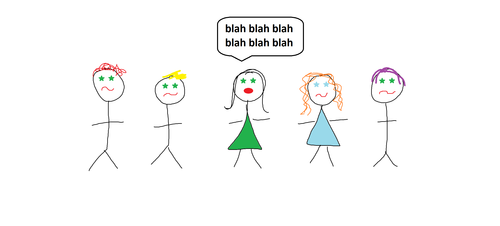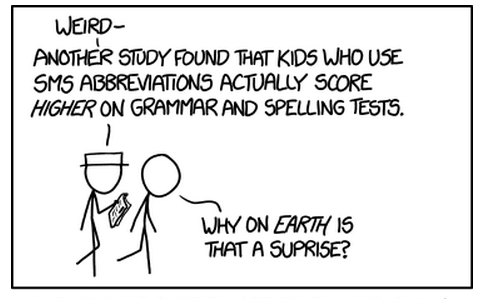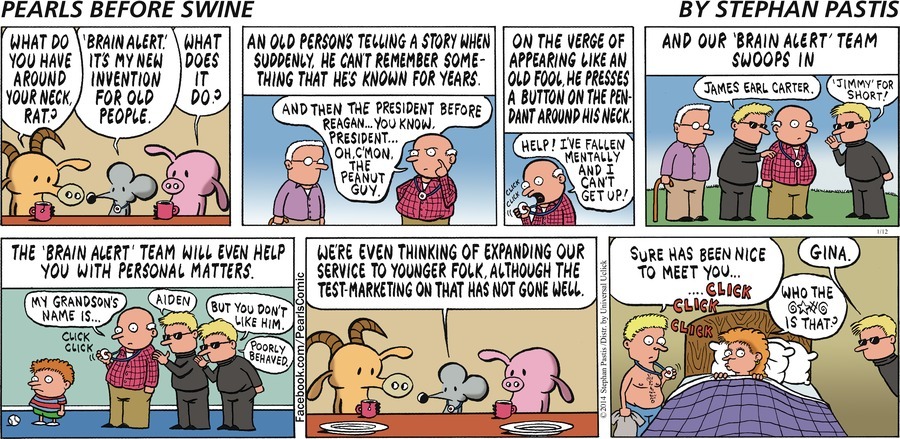Archive for Psychology of language
More on UM and UH
A few days ago ("Fillers: Autism, gender, and age" 7/30/2014), I noted an apparent similarity between male/female differences in UM/UH usage, and an autistic/typical difference reported in a poster by Gorman et al. at the IMFAR 2014 conference.
This morning I thought I'd take a closer look at the patterns in a large published conversational-speech dataset. Executive summary:
- There is a large sex difference in filled-pause usage, favoring males by about 38%
- There is an enormous sex difference in UM/UH ratio, favoring females by about 310%
- These sex differences are mainly driven by the difference in UH usage, which favors males by about 250%
- Older speakers use UH more and UM less, resulting in a large decrease of UM/UH ratios
The general pattern of gendered filled-pause usage in English has been at least partly replicated in several other datasets, including the spoken part of the British National Corpus, but the details are sometimes quite different. (See my earlier post, and planned future posts, for some discussion.) But all the important questions remain open, for example:
- Are the sex effects due to functional, iconic, or physiological differences between UM and UH, or are they arbitrary gender markers?
- Do the age effects reflect a change in progress, or a life-cycle effect (e.g. due to changes in sex hormone levels)?
- Are the patterns the same or different across geographical, socio-economic, and ethnic varieties of English?
- Are there analogous phenomena in other languages?
Read the rest of this entry »
Fillers: Autism, gender, and age
K. Gorman et al., "Children's Use of Disfluencies Distinguish ASD and Language Impairment", IMFAR 2014 (emphasis added):
This study compares the relative frequencies of "uh" and "um" in the spontaneous speech of children with ASD (with or without comorbid language impairment) to two control groups. Methods: Participants: 112 children ages 3;10–9;0 participated: ASD (50), Specific Language Impairment (SLI; 18), and Typical Development (TD; 44). All diagnoses were verified by best-estimate clinical consensus. The children with ASD were split into two groups: one group with comorbid language impairment (ALI) as diagnosed by a CELF Core Language Score below 85, and one group with ASD but no clinical language impairment (ALN). All children were high functioning monolingual English speakers. Data collection: a clinician administered the Autism Diagnostic Observation Schedule (ADOS; module 2 or 3) to each child. Sessions were recorded and transcribed.
Results: For all group pairs, diagnosis was uncorrelated with overall (i.e., "uh" + "um") rate of filled pause use. FP choice was analyzed for each comparison set using mixed effects logistic regression, with chronological age, FSIQ, ADOS "activity", and utterance position (utterance-initial vs. non-initial) as covariates. Diagnosis was a significant predictor for ALN/TD (p = .001) and ALI/SLI (p = .038); in both comparisons the ASD group used fewer instances of "um". Diagnosis was non-significant for TD/SLI (p = .888) and ALI/ALN (p = .814). ALI and ALN groups both used "uh" and "um" at an approximately 1:1 ratio, whereas TD and SLI groups used "um" 2 to 3 times more often than "uh". ADOS "activity" and utterance position were also significant predictors of FP choice; remaining covariates were non-significant.
Read the rest of this entry »
Want to get ahead as a woman in tech?
Learn to interrupt.
Below is a guest post by Kieran Snyder.

This week’s earlier posting on interruptions, in which I presented data to suggest that men interrupt more than women in the tech workplace, and that women are interrupted all the time by everyone, has easily been the most viewed, discussed, tweeted, and shared jenga post so far. This is due in no small part to the cross-posting picked up by Language Log, so many thanks to Mark Liberman for sharing it and to my linguist friends who suggested it. You can take the girl out of linguistics, but it’s hard to take linguistics out of the girl.
In case you missed the first post, a quick recap. In this totally observational and directional study, separate from any other factors, men interrupt women about three times as often as they interrupt other men. In a climate where interruptions happen on average once every two minutes and fifty-one seconds, there is less than one instance per hour of a woman interrupting a man for any reason. You get the idea: big tech is not an equitable environment as far as interruptions are concerned. This makes sense, since it is not a particularly equitable environment in terms of hiring and promotions either.
Read the rest of this entry »
Ur-etyma: how many are there?
This is another one of those posts that I started writing long ago (in this case back in January of 2012), but then set aside for one reason or another. However, such drafts and research notes usually reemerge on my radar screen sooner or later, especially if they are of compelling interest and potential significance. Now that it is summer time and I have a little bit of leisure to do what I like, I'm happy to return to this topic and finish it up.
Read the rest of this entry »
Vocal fry probably doesn't harm your career prospects
. . . but not being yourself just might.
There's been a lot of media interest recently in a new study of "vocal fry", sparked in part by an unusually detailed magazine article — Olga Khazan, "Vocal Fry May Hurt Women's Job Prospects", The Atlantic 5/29/2014. Other coverage: Gail Sullivan, "Study: Women with creaky voices — also known as ‘vocal fry’ — deemed less hireable", Washington Post 6/2/2014; "Is vocal fry hurting women's job prospects?", NPR Marketplace 6/5/2014; Maya Rhodan, "3 Speech Habits That Are Worse Than Vocal Fry in Job Interviews", Time Magazine 6/4/2014; and so on.
The original study is Rindy C. Anderson et al., "Vocal Fry May Undermine the Success of Young Women in the Labor Market", PLOSOne 5/28/2014. Below is a guest post by Christian DiCanio, offering a more skeptical take.
Read the rest of this entry »
Random letter-partition advantages in baby names
Commenting on "QWERTY again", 5/14/2014, Rubrick suggested that
It seems like an extremely simple way to check the validity of this theory would be to repeat the analysis, but with the letters grouped into two random subsets, rather than right-left subsets. In fact, I'd think the original authors should have done this as a control. If this new grouping yields a graph with any meaningful-looking trends whatsoever (or if multiple repeats of the analysis with different random subsets yield such trends a significant percentage of the time), it would pretty soundly deflate the idea that the original trends are the result of "right-hand favoritism".
Steve Kass followed up on this suggestion, providing five examples, and commenting that
The graphs don't all look the same, but they all look interesting, and several of them practically beckon the storyteller. There's something interesting about this general kind of data and "advantage function" analysis worth discovering, I think.
Read the rest of this entry »
QWERTY again
Various readers have pointed out to to me that the "QWERTY Effect" is back. (For coverage of the first QWERTY-Effect paper, see "The QWERTY Effect", 3/8/2012; "QWERTY: Failure to Replicate", 3/13/2012; "Casasanto and Jasmin on the QWERTY effect", 3/17/2012; and "Response to Jasmin and Casasanto's response to me", 3/17/2012.)
The new paper is Casasanto, D., Jasmin, K., Brookshire, G. & Gijssels, T. "The QWERTY Effect: How typing shapes word meanings and baby names". In P. Bello, M. Guarini, M. McShane, & B. Scassellati (Eds.), Proceedings of the 36th Annual Conference of the Cognitive Science Society. Austin, TX: Cognitive Science Society, 2014.
As before, the idea is that typing letters with the right hand makes us like them more; or in the words of their abstract,
Filtering words through our fingers as we type appears to be changing their meanings. On average, words typed with more letters from the right side of the QWERTY keyboard are more positive in meaning than words typed with more letters from the left: This is the QWERTY effect (Jasmin & Casasanto, 2012), which was shown previously across three languages. In five experiments, here we replicate the QWERTY effect in a large corpus of English words, extend it to two new languages (Portuguese and German), and show that the effect is mediated by space-valence associations encoded at the level of individual letters. Finally, we show that QWERTY appears to be influencing the names American parents give their children. Together, these experiments demonstrate the generality of the QWERTY effect, and inform our theories of how people’s bodily interactions with a cultural artifact can change the way they use language.
The most interesting new result is the baby-names experiment, in my opinion; and since I'm stuck in Heathrow Airport for a while, I thought I'd take a quick look at it.
Read the rest of this entry »
So much to read, so little time
This ubiquitous regret has long provided fodder for commercial exploitation—since the 1960s, speed reading courses have been marketed with promises to double or quadruple the rates at which text can be absorbed and understood. More recently, a number of speed reading apps for mobile devices have been released (e.g. Velocity, QuickReader, Acceleread), promising “superhuman” reading speeds that will “accelerate your learning potential” and help you “keep up with the web, blogs, twitter and e-mail.” (Now, if they could only invent an app for quadrupling the speed of answering e-mails, or writing Language Log posts, or thinking about what I’ve just read, that would truly increase my productivity.)
Of all these apps, the recently launched product Spritz offers the most specific pseudo-scientific hype as part of its marketing (their website offers a page soberly titled “The Science”). Since the stated rationalization for the app sounds plausible, at least to the point of managing to impress a number of smart, generally skeptical people who’ve sent me queries about it, it’s worth subjecting it to some psycholinguistic scrutiny.
Read the rest of this entry »
A zero-tolerance approach to PP attachment
Deborah Ball, "Pope Francis Appoints Eight to Sex-Abuse Commission", WSJ 3/22/2014:
Pope Francis on Saturday appointed a victim of sexual abuse and a senior cardinal known for his zero-tolerance approach to a new group charged with advising the Catholic Church on how to respond to the problem of sexual abuse of children.
The sequence "zero-tolerance approach to a new group" sent Tim Leonard down a syntactic garden path — he had to get past "charged with advising the Catholic Church" before he figured out that the cardinal was appointed to the new group rather than having a zero-tolerance approach to it. So Tim forwarded the example to me, and I had exactly the same experience.
Read the rest of this entry »
Too much information
Sunday's Pearls Before Swine:
This strip illustrates a well-documented aspect of aging:
While it is clear that more people now live longer than ever before in history, it is less obvious that this is a blessing. In Greek mythology, Tithonus was the mortal lover of Eos, goddess of the dawn. Eos asked Zeus to make Tithonus immortal but failed to mention “eternal youth,” dooming Tithonus to an eternity of physical and mental decay. The tithonean account of aging echoes loudly in the literature of the psychological and brain-sciences, which portrays adulthood as a protracted episode in mental decline, in which memories dim, thoughts slow, and problem-solving abilities diminish (Deary et al., 2009; Naveh-Benjamin & Old, 2008), and where researchers seem to compete to set the advent of cognitive decrepitude at an ever younger age (Salthouse, 2009; Singh-Manoux et al., 2012). Thus, although studies indicate that older adults are, on average, happier than younger adults (Charles & Carstensen, 2010), in the light of the foregoing, even this small crumb of comfort might be seen as further evidence of their declining mental prowess.
Read the rest of this entry »
Another little Chinese v. English experiment
With respect to yesterday's little perception experiment ("Can you tell the difference between English and Chinese?", 12/20/2013), Edward Lindon asked, semi-rhetorically:
Could the putative perceived similarities have any connection with the rhythms and inflections of the "broadcast voice"? Would the results be the same if the sample were composed of daily or conversational speech?
And Cygil responded, taking him literally:
Exactly. Newsreaderese is a bizarre dialect of English that, if you used in regular conversation, would immediately signal you as a madman.
This is absolutely all true, though incomplete — there are at least four or five quite distinct dialects of newsreaderese in English, and probably in other languages/cultures as well. See "Celebrity Voices", 3/26/2011, for some discussion.
So this morning, I've selected eight phrases at random from published corpora of conversational telephone speech in English and in Mandarin, and you can try the same experiment again.
Read the rest of this entry »
Can you tell the difference between English and Chinese?
… from the pitch contours alone? It should be easy, right? Chinese is a tone language, English isn't, etc.
So try it…
Read the rest of this entry »

